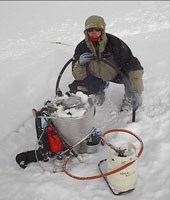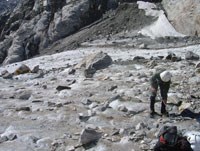
Our methods require us to visit each glacier at least two times annually. In late-April, when the accumulation season is ending, we probe thickness of the snow pack across the surface of the entire glacier. At the same time, we use a backpack-mounted steam drill to melt holes 8-9m into the glaciers (Figure 5). Four to five stakes per glacier are placed in these holes and are used to monitor the amount of the previous winter's snow, as well as underlying firn and ice that melts through the following summer. North Klawatti and Noisy glaciers have five stake stations, while the others have only four stations as a result of size and topographic characteristics. A late September visit is used to measure final melting and remove the stakes (Figure 6, 7). Mid-summer measurements are used to provide additional data on rate and processes of melting (Figure 8). Measurements taken at the stakes are averaged across the entire glacier to determine mass balance. 


|
Last updated: August 11, 2017
